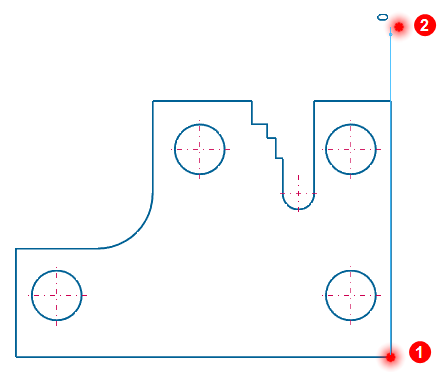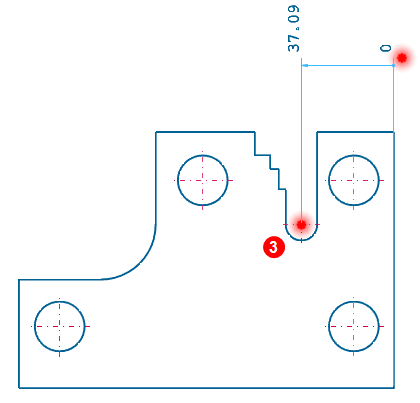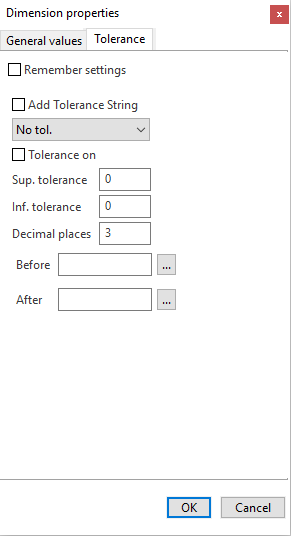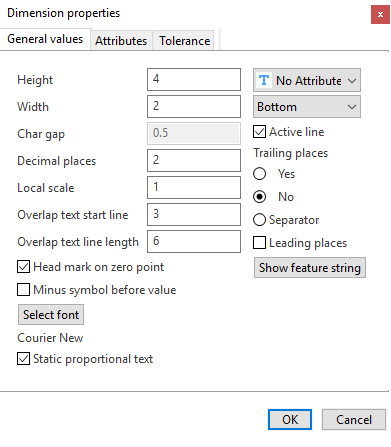Ordinate dimension
This function allows you to create a series of linear dimensions.
The first dimension always has the value "0" and is considered as the reference dimension for any others, which will have a value corresponding to the distance from it.
The dimensions are automatically generated with a parallel alignment in respect to the orientation of the first one and aligned at its application point.
Note:
This command only requires the picking of one point at each step.
Access
- Click the Ordinate
icon in the Annotations tab.
Or
- Type Ordinate in the Quick Search field and select Ordinate dimensions.
This opens the tab containing the General, Filters and Attributes sections.
Procedure
- Select the appropriate options from the Filters and Attributes sections of the Options tab.
Note: Alternatively you can select the 4 sides function from the General section of the Options tab.
- Select the starting point (zero point)
 . Its value is always "0" and will be used as the origin for calculating subsequent dimensions.
. Its value is always "0" and will be used as the origin for calculating subsequent dimensions. - Identify the application point
 of the first dimension related to the starting point. This will be the reference for the alignment of all dimensions created before exiting the command.
of the first dimension related to the starting point. This will be the reference for the alignment of all dimensions created before exiting the command.Note: the position of the first dimension is displayed dynamically depending on the mouse position. Before validation, it is possible to perform the following operations from the General section of the Options tab:
Select the X-axis or the Y-axis direction by dragging the zero point in the required direction or click the Direction
icon to select a different direction by selecting an existing segment or line in the graphic area.
- Load the Dimension Properties dialog by clicking on the Properties
icon. This dialog can also be loaded by pressing the [T] Key to enter and configure text after validation.(See Ordinate Dimension Properties).
Select multiple points having the same characteristics (defined through the Filters icons) for automatic dimensioning by activating the Into a windows
icon and drawing a rectangle around the required area in the graphic area.
- Turn on / off the active lines display by using the Active line
icon.
-
Continue to create as many Ordinate dimensions as you may need by sequentially selecting all the required points. For example select the centre of the circle
 .
.Note: From now on, it will be possible to define only new Dimension Properties ( Properties
icon or [T] Key) and activate the selection of specific points / elements included in a defined area (Into a windows
icon).
- Once the last required dimension of the Ordinate has been identified, click the right mouse button or click on the Apply icon
to validate.


Notes:
- The Ordinate dimensions created refer to the starting point (zero point)
 defined at Step 2 and will be aligned at its application point.
defined at Step 2 and will be aligned at its application point. - The top left corner of the screen always displays the value of the previously positioned dimension and the dynamic value of the current dimension still to be positioned.
- If two dimensions are too close and the texts overlap, an automatic step is created.
 See image.
See image.
- During the creation of each single dimension, it is possible to select the Grid parameters icon
. The grid will work around the absolute co-ordinate facilitating the dimensions alignment.
Ordinate Dimension Properties
This dialog is loaded during the Ordinate dimensions creation, Ordinate dimension editing and Ordinate dimension(s) adding.
General values Tab

|
Remember settings |
Activate this option to save your current settings. |
|
Text |
Enter the text string in this field. You can use keyboard shortcuts to add special characters:
|
|
Decimal places |
Enter the number of decimal places in this field. |
|
Minus symbol before value |
Activate this option to display the minus symbol before the Ordinate dimension values when applicable. |
|
Text attribute |
Select the text attribute from the drop-down list: No Attribute, Underline, Overline, etc. |
|
Text colour |
Select the text colour. |
|
Tolerance colour |
Select the tolerance colour (See Tolerance Tab). |
Tolerance Tab

|
Remember settings |
Activate this option to save your current settings. |
|
Add Tolerance String |
Activate this option to enable the drop down menu from which to select a predefined text to be added after the Ordinate dimension value: No Tol., (4 holes), (2 holes), Symm 0,05, etc... . |
|
Tolerance on |
Activate this option to display the tolerance values defined in the Sup. tolerance and Inf. Tolerance fields. |
|
Sup. tolerance |
Enter the upper limit value of the admitted tolerance range. This value displays after the dimension value. |
|
Inf. tolerance |
Enter the lower limit value of the of the admitted tolerance range. This value displays after the dimension value. |
|
Decimal places |
Enter the number of decimal places to display. |
|
Before |
Enter the text to be added before the dimension. This option allows you to select predefined text in the application:
|
|
After |
Enter the text to be added after the dimension. This option allows you to select predefined text in the application:
|
Ordinate Annotation Properties
This dialog is loaded during Ordinate annotation editing. The edited properties apply to the whole set of dimensions.
General values Tab

|
Height |
Enter the height of characters in this field. |
|
Width |
Enter the width of characters in this field (only for static text). It is disabled if the Static proportional text option is activated. |
|
Char gap |
Enter the distance between each character in this field. It is disabled if the Static proportional text option is activated. |
|
Decimal places |
Enter the number of decimal places to display. |
|
Local scale |
Enter a new text scale in this field. |
|
Overlap text start line |
Enter the extra horizontal and vertical displacements to be applied to reposition individual Ordinate dimensions in case of overlapping. |
|
Overlap text line length |
|
|
Head mark on zero point |
Activate this option to mark the starting point (zero point). |
|
Minus symbol before value |
Activate this option to display the minus symbol before the Ordinate dimension values. |
|
Select font |
Click this button to define the font parameters. |
|
Static proportional text |
When this option is activated, proportional text is applied; the width of characters is calculated as a ratio relative to the height of characters. |
|
Text attribute |
Select the text attribute in this drop-down list: Underline, Overline, etc. |
|
Text position |
Select the text position with respect to the witness line: Bottom, Centre, Top (in case of vertical orientation of the dimensions these options corresponds to left, centre and right ). |
|
Active line |
Activate this option to display, by default, the intermediate active lines. |
|
Trailing places |
Select whether you want to display (Yes) the insignificant zeros following the decimal places or not (No). |
|
Separator |
Activate this option to draw a point after the integer when there are no trailing places. |
|
Leading places |
Activate this option to display all of the insignificant zeros which precede the decimal place. |
|
Show feature string |
Click this button to display the CAM string defined inside the "Feature.cfg" file. |
Attributes Tab

|
Text colour |
Select the text colour. |
|
Arrow Style |
Select the arrow style displayed at the extremity of the dimension line. |
Tolerance Tab

|
Add Tolerance String |
Activate this option to display the tolerance settings. Select the tolerance settings from the drop-down list below the option. |
|
Tolerance on |
Activate this option to insert tolerance text after the dimension value. |
|
Sup. tolerance |
This field indicates the upper tolerance value. The value depends on the tolerance settings selected in the Add Tolerance String drop-down list. |
|
Inf. tolerance |
This field indicates the lower tolerance value. The value depends on the tolerance settings selected in the Add Tolerance String drop-down list. |
|
Tolerance dual value |
Activate this option to display the upper and lower tolerance values between brackets after the dimension value. |
|
Double dimension |
Activate this option to display the dimension value in both mm and inches. |
|
Decimal places |
Enter the number of decimal places in this field. |
|
Trailing places |
Activate this option to display the insignificant zeros following the decimal places. |
|
Leading places |
Activate this option to display all of the insignificant zeros which precede the decimal place. |
|
Tolerance position |
Select whether to position the upper and lower tolerance value levels at the Bottom of the dimension value or in the Middle of the dimension value. |
|
Before |
Enter the text to be added before the dimension in this field. This option allows you to select predefined text in the application:
|
|
After |
Enter the text to be added after the dimension in this field. This option allows you to select predefined text in the application:
|
Editing existing Ordinate annotation
- See Edit dimension.

